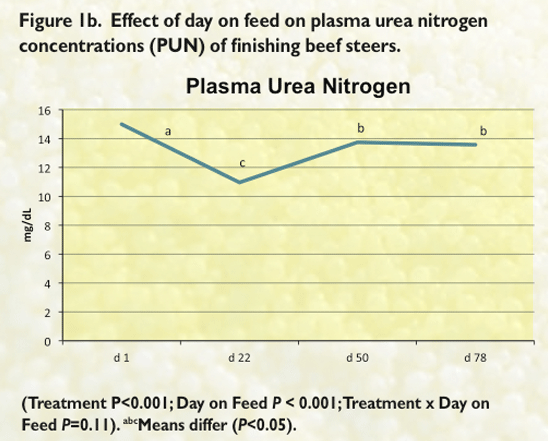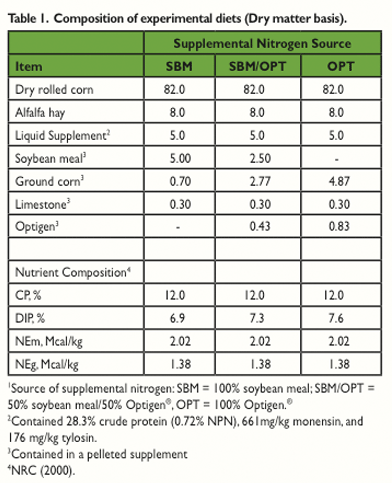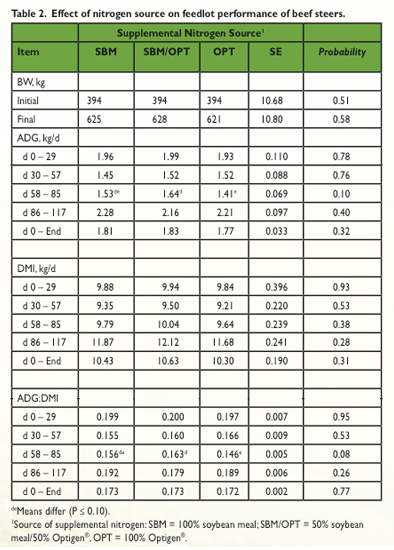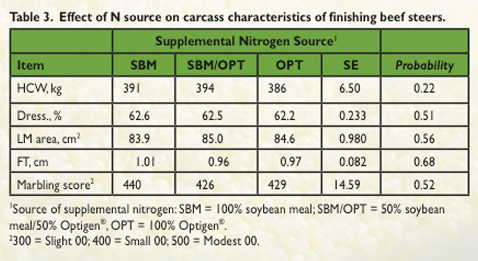



Optigen To Replace Soybean Meal Nitrogen
B Holland and J Jennings, from the Department of Animal and Range Sciences, South Dakota State University, look at using Optigen to replace soybean meal nitrogen in dry rolled corn-based finishing diets for beef steers.Introduction
Urea is often a cost effective source of non-protein nitrogen for beef cattle finishing diets. However, because of its rapid degradation in the rumen, available ammonia may exceed capacity for ruminal microbial synthesis.
For this reason, urea inclusion in finishing diets has been limited to less than 1.5 per cent of dry matter. Because the maximal rate of microbial protein synthesis is dependent on ruminal starch degradation, maximal urea inclusion may be lower when less extensively processed grains, such as dry rolled corn, are used.
Traditionally, oilseed meals have often been used to provide supplemental nitrogen in feedlot diets in addition to urea. Optigen (Alltech Inc.) is a slow-release source of non-protein nitrogen that degrades at a rate similar to soybean meal. However, the effects of replacing soybean meal nitrogen with Optigen® in dry-rolled corn-based finishing diets for beef cattle has not been investigated.
Objective
Evaluate the effects of replacing soybean meal nitrogen with Optigen on growth performance, carcass characteristics, and plasma urea nitrogen (PUN) concentrations of feedlot steers.
Materials and Methods
Cattle and Experimental Treatments- Study conducted at the Southeast South Dakota Experiment Farm (Beresford, SD).
- 192 British crossbred steers (BW = 410 ± 23.6 kg) were used in the experiment.
- Steers were implanted with trenbalone acetate and estradiol (Revalor-S, Intevet/Schering-Plough Animal Health, Millsboro, DE) at the beginning of the experiment.
- Blocked by weight into 5 blocks and randomly assigned to 3 pens within each block (n = 12 or 13 steers/pen).
- Pens were randomly assigned to one of three dietary treatments (Table 1; n = 5 pens/treatment). All diets contained dry-rolled corn, a liquid supplement that provided one per cent equivalent crude protein from urea, and alfalfa hay. Additional supplemental nitrogen was supplied by:
- Soybean meal (SBM)
- 50 per cent soybean meal and 50 per cent Optigen® (SBM/OPT)
- 100 per cent Optigen® (SBM)
- Steers were adapted to the finishing diet over a 12-d period using 2 step-up diets.
- A ‘slick-bunk’ management approach was used, and steers were fed once daily.
- Based on visual appraisal and BW, steers were slaughtered at a commercial abattoir on d 118 (blocks 3, 4, and 5) or 146 (blocks 1 and 2).
Measurements
- Steers were weighed individually on d -1, 0, and 1 d prior to slaughter, and on a pen basis on d 29, 57, and 85.
- Carcase data were collected using camera grading equipment. Data included HCW, 12th-rib fat thickness, longissimus muscle area, estimated KPH, and USDA yield and quality grades.
- On d 1, 22, 50, and 78, blood was collected approximately 5 h after feeding from 6 animals/pen for measuring plasma urea nitrogen (PUN) concentrations.
Statistical Analysis
Data were analysed as a randomised complete block design using the MIXED procedure of SAS (SAS Institute, Cary, NC) with the fixed effect of supplemental nitrogen source. Weight block was included as a random effect. Plasma urea nitrogen concentrations were analysed as repeated measures using the MIXED procedure of SAS. Pen was the experimental unit for all variables, and differences were considered significant when P≤0.05.
Results
- Final BW, overall ADG, DMI, and ADG:DMI were similar across supplemental nitrogen sources (P≥0.31).
- However, steers fed SBM/OPT tended to gain faster and be more efficient than OPT steers from d 58 to 85.
- Carcase characteristics were similar across nitrogen sources.
- No interactions between day on feed and diet were observed in PUN concentrations.
- The high PUN concentrations observed on d 1 resulted from the pre-trial receiving diet which contained 16.6 per cent crude protein (DM basis) due to high inclusion of wet distillers grains and alfalfa hay.
- Plasma urea nitrogen concentrations increased from d 22 to d 50 and 78. This was expected in maturing animals, as nitrogen accretion slows.
- Replacing soybean meal nitrogen with Optigen increased PUN concentrations, possibly indicating decreased efficiency of N utilisation by cattle fed Optigen rather than soybean meal.
Implications
The data suggests that Optigen can replace a portion, or all, the nitrogen supplied by soybean meal in a dry-rolled corn-based finishing diet for beef steers without resulting in losses in performance.







